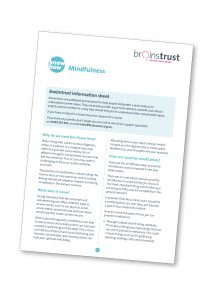Brain tumour know hows
Quick guides to give you key facts about important topics to you on your brain tumour journey.
Taking control
Mindfulness
 The practice of mindfulness is about taking the time to focus on one particular task or activity, feeling relaxed yet awake and aware, and being completely in the present moment.
The practice of mindfulness is about taking the time to focus on one particular task or activity, feeling relaxed yet awake and aware, and being completely in the present moment.
When practised regularly, mindfulness can help to reduce stress and anxiety, which can help your emotional well-being and aid sleep. This Know How explores way that you can practice mindfulness when living with a brain tumour.
Download the Mindfulness Know How
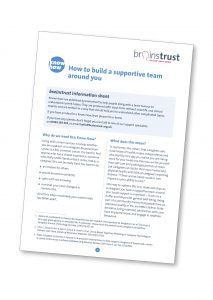 How to build a supportive team around you
How to build a supportive team around you

Because brain cancer is a less common cancer, it is hard to find anyone who has a shared experience, someone who really understands what it is like. And as a caregiver, this can be really hard. One way to address this is to make sure that, as a caregiver, you have a supportive team around you. Social support is important – it acts as a buffer and helps with general well-being.
This Know How will help you build a supportive team so you can cope better when a loved one has a brain tumour.
Download the How to build a supportive team around you Know How
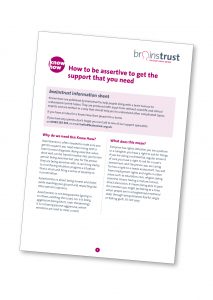 How to be assertive
How to be assertive

Assertiveness is often needed to make sure you get the support you need when living with a brain tumour diagnosis. Being assertive, when done well, can be transformative. It can bring clarity to a confusing situation, progress a situation that is stuck and bring a sense of equality to a conversation.
This Know How will help you use assertiveness to get the support that you need.
Download the How to be assertive Know How
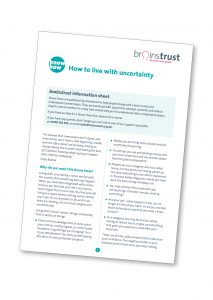 How to live with uncertainty
How to live with uncertainty

When you have been diagnosed with a brain tumour, you feel that your life is less secure, more fragile than it once was. You find yourself living in a space where nothing seems certain anymore. It’s a scary place to be, and it can leave you feeling out of control and overwhelmed.
This Know How will help you get comfortable with living with uncertainty.
Download the How to live with uncertainty Know How
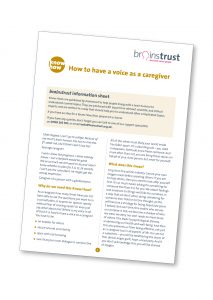 How to have a voice as a caregiver
How to have a voice as a caregiver

Being a caregiver is a daunting role – you need compassion, fortitude and fierce resilience. And more often than not, you are living these values on behalf of your close person, but never for yourself.
This Know How will help you find your voice as a caregiver of someone with a brain tumour.
Download the How to find your voice as a caregiver Know How
Dealing with the overwhelm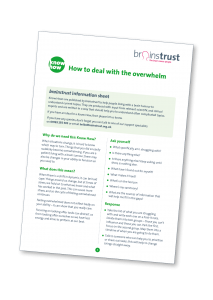

When situations change, it is hard to know which way to turn. Things that you did so easily suddenly become overwhelming. If you are a person living with a brain tumour, there may also be changes in your ability to function as you used to. Some things are within your power to change. Some are not. This Know How is designed to help you understand the difference, and prioritise the things that you can have an impact on.
Download the Overwhelm Know How
How to handle conflict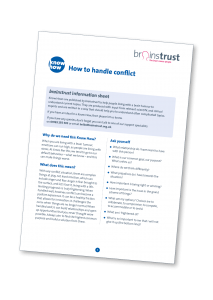

When you are living with a brain tumour, emotions can run high, as people are living with stress. At times like this, we tend to go to our default behaviour – what we know – and this can make things worse. This Know How will help you understand how to handle conflict, and try and turn it into something productive.
Download the How to handle conflict Know How
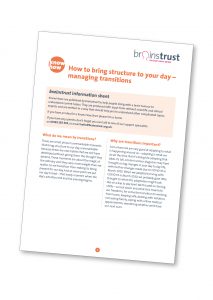 How to bring structure to your day
How to bring structure to your day
As humans we are very good at adapting to what is happening around us- adapting is what we do all the time. But it is doing the adapting that takes its toll. A brain tumour diagnosis may have brought on big changes in your day to day life, with further changes made due to COVID-19 in March 2020.
In this Know How you find strategies to help you to bring structure into your day and manage these transitions.
Download the How to bring structure to your day Know How
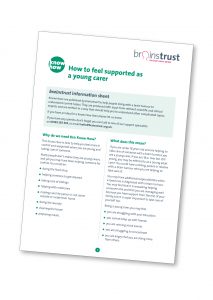 How to feel supported as a young carer
How to feel supported as a young carer
If you are under 18 years old and are helping to take care of someone with a brain tumour, you are a young carer. You could have a sibling, parent or relative with a brain tumour who you are helping to take care of.
This Know How will help you to feel more in control and supported as a young carer.
Download the How to feel supported as a young carer Know How
How to deal with scanxiety
 When you are diagnosed with a brain tumour,
When you are diagnosed with a brain tumour,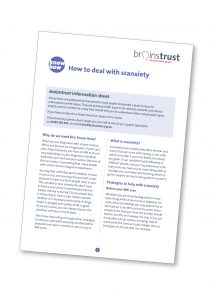 MRI scans become an integral part of your care plan. Because of this, scanxiety – fear and nerves around both the scan and the results – is something that many people with a brain tumour diagnosis experience.
MRI scans become an integral part of your care plan. Because of this, scanxiety – fear and nerves around both the scan and the results – is something that many people with a brain tumour diagnosis experience.
This Know How will go through some strategies to help you cope with scanxiety and feel better prepared and more in control in the run-up to MRI scans.
Download the ‘How to deal with scanxiety’ Know How
 Coping with bereavement
Coping with bereavement
Losing somebody that you love is devastating, and can coping with your grief can feel incredibly isolating.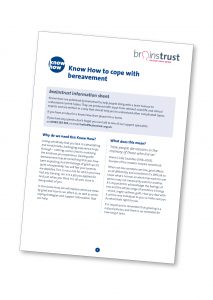
When somebody close to you passes away following a brain tumour diagnosis, although it may be something that you have been expecting, the feelings of grief can hit quite unexpectedly. Losing somebody that you love is a devastating and emotionally challenging experience to go through, and nothing comes close to matching the emotions you experience.
In this Know How, we will explore what we mean by grief and how it can affect us, as well as some coping strategies and support information that can help.
Download the ‘coping with bereavement’ Know How
How to make the best of the time I have left
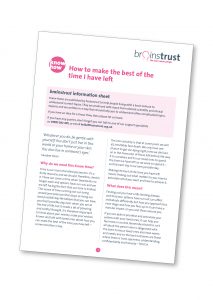 There can come a time when treatments no longer work and options have run out, and we are left facing the fact that our time is limited.
There can come a time when treatments no longer work and options have run out, and we are left facing the fact that our time is limited.
This Know How will explore more about making the best of the time you have left including finding out what matters to you and how to achieve it.
Download the ‘how to make the best of the time I have left’ Know How
How to set personal boundaries
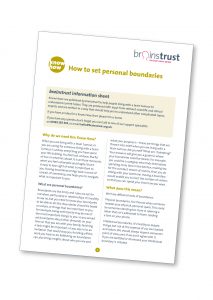 When you are living with a brain tumour, or you are caring for someone living with a brain tumour it can leave you feeling lost and fearful of what lies ahead. Having boundaries can bring back a sense of control and help you to navigate what it is important to you.
When you are living with a brain tumour, or you are caring for someone living with a brain tumour it can leave you feeling lost and fearful of what lies ahead. Having boundaries can bring back a sense of control and help you to navigate what it is important to you.
This Know How will explore what we mean by personal boundaries and how you can set them.
Download the ‘how to set personal boundaries’ Know How
How to feel part of a community
 When living with a brain tumour diagnosis, you may automatically find yourself being part of a community that you never intended to or wanted to become a part of.
When living with a brain tumour diagnosis, you may automatically find yourself being part of a community that you never intended to or wanted to become a part of.
This Know How will explore more about what it means to be part of a community when living with a brain tumour diagnosis and how you can get involved and build a supportive network around you.
Download the ‘how to feel part of a community’ Know How
How to find a new normal
 If you can find a new normal following a brain tumour diagnosis, it means that you can own the situation, take control and live with the life you want.
If you can find a new normal following a brain tumour diagnosis, it means that you can own the situation, take control and live with the life you want.
This Know How will explore what this means and some strategies to help you find a way forward.
Download the ‘how to find a new normal’ Know How
How to feel less alone
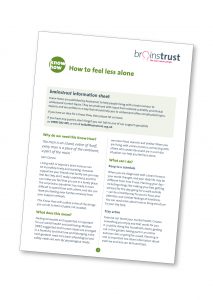 Living with or beyond a brain tumour can be incredibly lonely and isolating.
Living with or beyond a brain tumour can be incredibly lonely and isolating.
This Know How will outline some of the things you can do to feel included, not isolated.
Download the ‘how to feel less alone’ Know How
Newly diagnosed- knowing what to ask
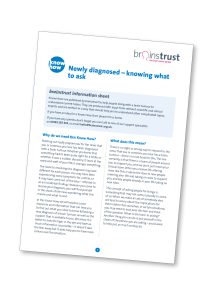 Nothing can really prepare you for the news that you or someone you love has been diagnosed with a brain tumour.
Nothing can really prepare you for the news that you or someone you love has been diagnosed with a brain tumour.
In this Know How, we will explore some resources and information that can help you to find out what you need to know following a new diagnosis of a brain tumour and the support that is available to you.
Download the ‘newly diagnosed’ Know How
How to manage changes in your relationship
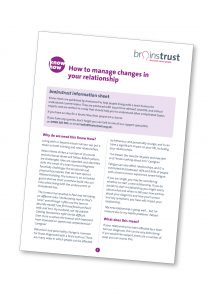 Living with or beyond a brain tumour can put a strain on both existing and new relationships.
Living with or beyond a brain tumour can put a strain on both existing and new relationships.
In this Know How, we will explore some resources and information that can help you to manage changes in relationships when you or someone closed to you is diagnosed with a brain tumour.
Download the ‘how to manage changes in your relationships’ Know How
Information about treatment
How to get a second opinion

We are often asked about second or even third opinions. Seeking more opinions has both advantages and disadvantages. This Know How has been designed to help you understand the pros and cons of a second opinion, bring some clarity as to what the options are and inform you how to go about seeking another opinion.
Download the Second opinion Know How
Immunotherapy: DCVax®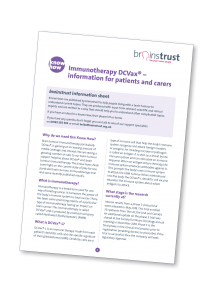
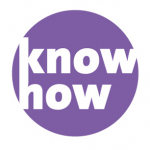
Brain tumour immunotherapy, particularly DCVax®, is gaining an increasing amount of media coverage and interest. We are seeing a growing number of calls to our support helpline about DCVax® and brain tumour immunotherapy. This Know How sheds some light on the current state of play for one particular brain tumour immunotherapy trial and some recently published results.
Download the DCVax® Know How
Meningioma brain tumours and the contraceptive injection
Recent research (2024) has uncovered a potential link between long-term use of medroxyprogesterone acetate (Depo Provera is one brand name), a widely used contraceptive injection, and an increased risk of developing meningioma, a typically non-malignant brain tumour. This Know How explores this in more depth and looks at the risks and benefits.

Download the ‘Meningioma brain tumours and the contraceptive injection’ Know How
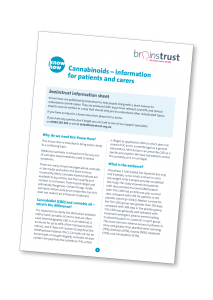 Cannabinoids
Cannabinoids

This Know How is intended to bring some clarity to a confusing topic. Medicinal cannabis is a broad term for any sort of cannabis-based medicine used to relieve symptoms. There are many mixed messages about cannabis in the media and within the brain tumour community. Many cannabis based products are available to buy online, but their quality and content is not known. They may be illegal and potentially dangerous. Certain things inside cannabis contain anticancer properties, but this does not make it an anticancer treatment.
Download the Cannabinoids Know How
 Ketogenic diets
Ketogenic diets
Certain diets and nutritional approaches are often spoken about in the media and elsewhere as being potentially helpful for people living with a brain tumour diagnosis, which may have caused you to wonder whether you should be thinking about particular nutritional approaches for your health.
This Know How offers an overview of the ketogenic diet in order to help you decide whether this is something that you wish to consider for yourself.
Download the Ketogenic diets Know How
 How to prepare for medical appointments
How to prepare for medical appointments
When you are living with a brain tumour diagnosis, this can mean that you will have regular medical appointments and check-ups at any stage of the pathway. They are a key part of your clinical care and are where you will get key information about your condition and treatment plan.
This Know How will help you to prepare for your medical appointments through different tips and strategies.
Download the How to prepare for medical appointments Know How
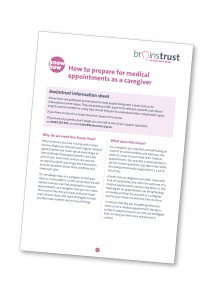 How to prepare for medical appointments as a caregiver
How to prepare for medical appointments as a caregiver
When someone you love is living with a brain tumour diagnosis, they will have regular medical appointments and check-ups at each stage of their pathway. These appointments are a key part of your loved one’s clinical care and are an opportunity for you to get key information and ask questions about their condition and treatment plan.
It’s not always easy as a caregiver to find your voice in a consultation. In this Know How, we will explore how you can feel prepared for medical appointments as a caregiver, how you can make the most of the time you have with your loved one’s clinical team, and some strategies to help you feel more resilient and on top of things.
Download the How to prepare for medical appointments as a caregiver Know How
Artificial intelligence- Information for patients and caregivers
 Artificial intelligence, or AI, already plays a key role in brain tumour diagnosis and treatment. The government
Artificial intelligence, or AI, already plays a key role in brain tumour diagnosis and treatment. The government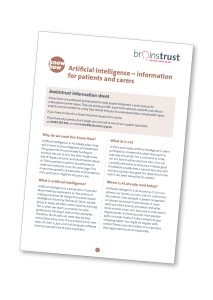 has provided funding to increase the use of AI in the NHS. People have lots of hopes, concerns and uncertainties about AI. These questions need to be addressed to make sure everyone is on the same page.
has provided funding to increase the use of AI in the NHS. People have lots of hopes, concerns and uncertainties about AI. These questions need to be addressed to make sure everyone is on the same page.
This Know How presents the benefits and limitations of AI, and how it might fit into your care.
Download the Artificial Intelligence Know How
Know how to talk with your neurosurgeon about tissue collection
 When you are having surgery for a brain tumour, it is important that you talk with your neurosurgeon about what
When you are having surgery for a brain tumour, it is important that you talk with your neurosurgeon about what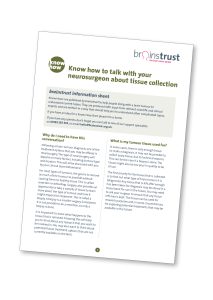 will happen to the tumour tissue that is removed. This know how will help you to understand the options available and the things you need to think about.
will happen to the tumour tissue that is removed. This know how will help you to understand the options available and the things you need to think about.
Download the tissue collection Know How
How to prepare for hospital discharge
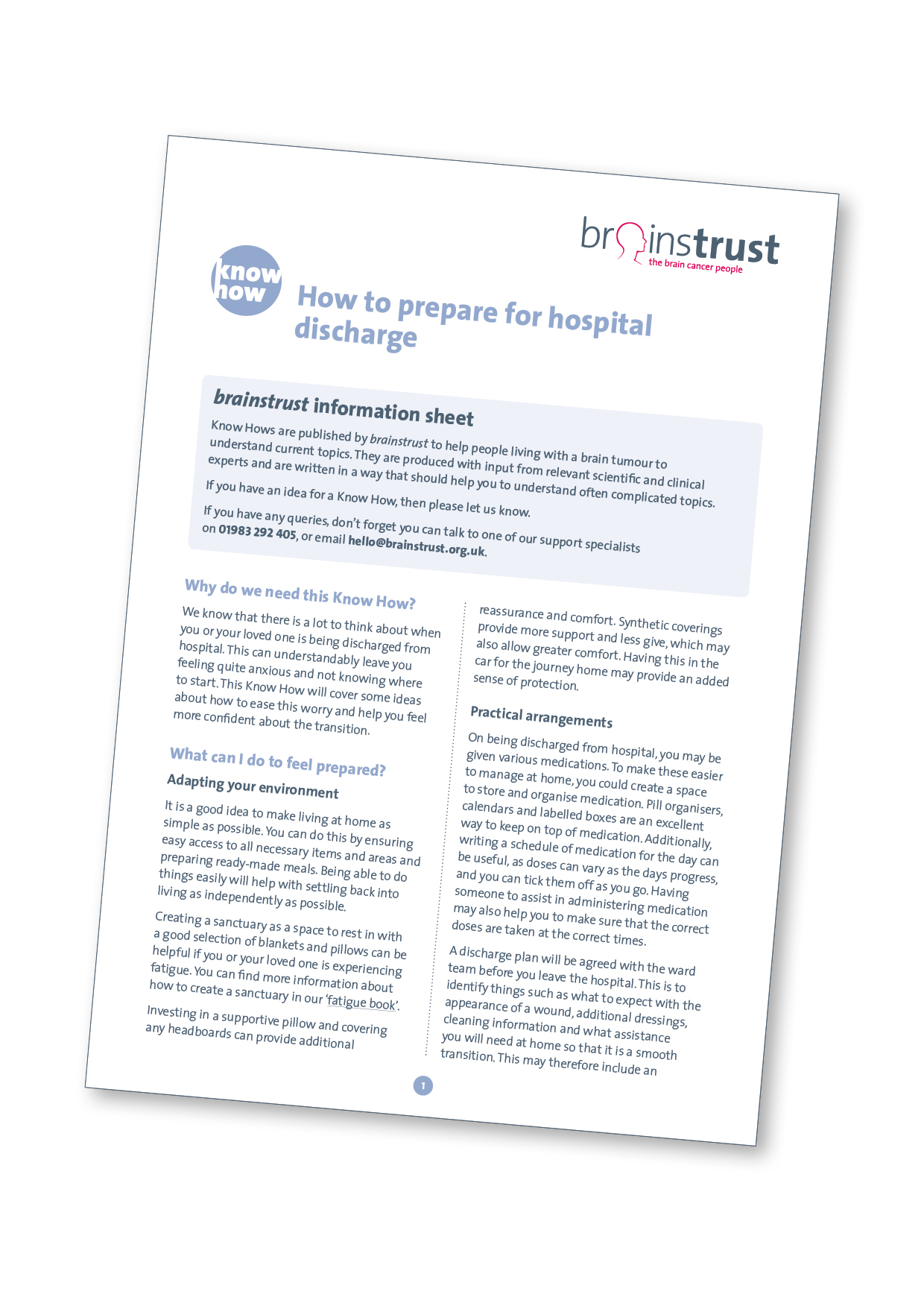
 There is a lot to think about when you or your loved one is being discharged from hospital. This can leave you feeling quite anxious, and it can be hard to know where to start. This Know How covers some ideas about how to ease this worry and help you feel more confident about the transition.
There is a lot to think about when you or your loved one is being discharged from hospital. This can leave you feeling quite anxious, and it can be hard to know where to start. This Know How covers some ideas about how to ease this worry and help you feel more confident about the transition.
Download the hospital discharge know how.
Practical advice
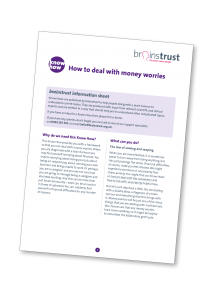 Money worries
Money worries
 When you are diagnosed with a brain tumour, you may find yourself worrying about finances. You may be worrying about losing your job, about being on reduced pay, about running your own business and being unable to work. Or perhaps you are a caregiver, and you are not sure how you are going to manage being a caregiver and also keep working. You can suddenly find yourself in financial difficulties for any number of reasons.
When you are diagnosed with a brain tumour, you may find yourself worrying about finances. You may be worrying about losing your job, about being on reduced pay, about running your own business and being unable to work. Or perhaps you are a caregiver, and you are not sure how you are going to manage being a caregiver and also keep working. You can suddenly find yourself in financial difficulties for any number of reasons.
This Know How provides you with a framework so that you can deal with money worries.
Download the Money worries Know How
Lasting power of attorney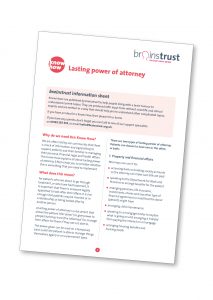

We are often told by our community that there is a lack of information and signposting to support patients and their families in managing their personal, financial, legal and health affairs.
This Know How explains all about lasting power of attorney (LPA) to help you to consider whether this is something that you need to implement.
Download the Lasting power of attorney Know How
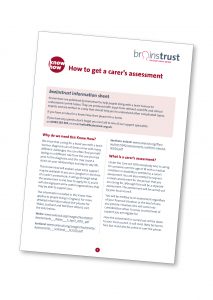 How to get a carer’s assessment (England)
How to get a carer’s assessment (England)

This Know How will explain what extra support may be available to you as a caregiver in the form of a carer’s assessment. It will go through what the assessment is and how to apply for it, and it will also signpost some useful organisations that may be able to support you.
Download the How to get a carer’s assessment Know How
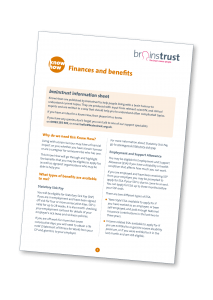 Finances and benefits
Finances and benefits
 No longer being able to work, new and expensive mobility requirements, having to travel long distances to get to hospital – whatever the reasons for you, having a brain tumour can be a huge financial strain.
No longer being able to work, new and expensive mobility requirements, having to travel long distances to get to hospital – whatever the reasons for you, having a brain tumour can be a huge financial strain.
The latest brain tumour Know How covers finances and benefits that could support you and your family when one of you has a brain tumour.
Download the Finances and benefits Know How
Reliable websites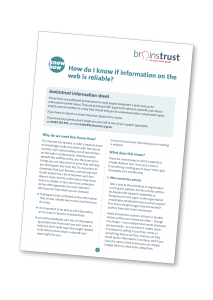
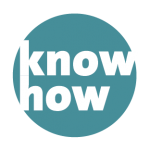 Access to the internet at the tips of our fingers has made getting hold of information quicker and easier than ever, but how can you know what sources to trust? Misinformation spreads fast online, and is sometimes shared by people with a large following.
Access to the internet at the tips of our fingers has made getting hold of information quicker and easier than ever, but how can you know what sources to trust? Misinformation spreads fast online, and is sometimes shared by people with a large following.
This Know How will help you to understand what reliable websites look like, establish fact from fiction online and stop feeling overwhelmed by the volume of information available.
Download the Reliable websites Know How
Driving
 We know that you have lots of questions about the impact your diagnosis will have on your ability to drive. If you need to give up your driving license, this has a massive impact on your independence and well-being.
We know that you have lots of questions about the impact your diagnosis will have on your ability to drive. If you need to give up your driving license, this has a massive impact on your independence and well-being.
This latest Brain Tumour Know How covers everything from telling your insurance provider, how long it might be until you can drive again to ways to manage the loss of your license.
Download the Driving Know How
Returning to work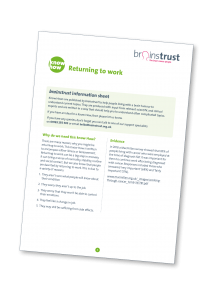
 Returning to work can be a big step in recovery. It can bring a sense of normality, stability, routine and social contact. But we also know that it can be very daunting. This Know How will help you to prepare for returning to work, understand what help is available to you.
Returning to work can be a big step in recovery. It can bring a sense of normality, stability, routine and social contact. But we also know that it can be very daunting. This Know How will help you to prepare for returning to work, understand what help is available to you.
It has been written to encompass returning to work after bereavement as well as illness.
Download the Returning to work Know How
The choice of topics are driven by the needs of our community. So, if we have lots of questions around a focus, such as immunotherapy – hey presto, a Know How will be written.
Where a Know How involves health information, they are written following our rigorous Information Standard process, so that you know the information is trustworthy and reliable.
If you would like a Know How written, please email hello@brainstrust.org.uk. And of course, if you’d like to chat about any of these Know Hows then don’t hesitate to get in touch.


